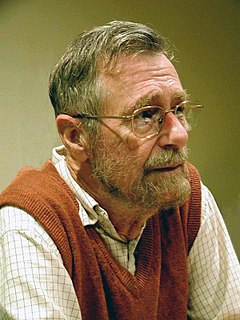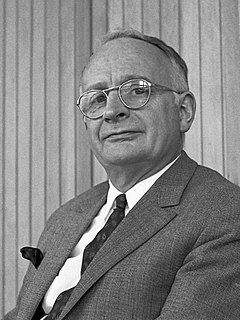Related Research Articles
CORAL, short for Computer On-line Real-time Applications Language is a programming language originally developed in 1964 at the Royal Radar Establishment (RRE), Malvern, Worcestershire, in the United Kingdom. The R was originally for "radar", not "real-time". It was influenced primarily by JOVIAL, and thus ALGOL, but is not a subset of either.

Edsger Wybe Dijkstra was a Dutch computer scientist, programmer, software engineer, systems scientist, science essayist, and pioneer in computing science. A theoretical physicist by training, he worked as a programmer at the Mathematisch Centrum (Amsterdam) from 1952 to 1962. A university professor for much of his life, Dijkstra held the Schlumberger Centennial Chair in Computer Sciences at the University of Texas at Austin from 1984 until his retirement in 1999. He was a professor of mathematics at the Eindhoven University of Technology (1962–1984) and a research fellow at the Burroughs Corporation (1973–1984). In 1972, he became the first person who was neither American nor British to win the Turing Award.

Niklaus Emil Wirth is a Swiss computer scientist. He has designed several programming languages, including Pascal, and pioneered several classic topics in software engineering. In 1984, he won the Turing Award, generally recognized as the highest distinction in computer science, for developing a sequence of innovative computer languages.

Stephen Richard "Steve" Bourne is an English computer scientist based in the United States for most of his career. He is well known as the author of the Bourne shell (sh), which is the foundation for the standard command-line interfaces to Unix.
The Royal Radar Establishment was a research centre in Malvern, Worcestershire in the United Kingdom. It was formed in 1953 as the Radar Research Establishment by the merger of the Air Ministry's Telecommunications Research Establishment (TRE) and the British Army's Radar Research and Development Establishment (RRDE). It was given its new name after a visit by Queen Elizabeth II in 1957. Both names were abbreviated to RRE. In 1976 the Signals Research and Development Establishment (SRDE), involved in communications research, joined the RRE to form the Royal Signals and Radar Establishment (RSRE).
The Royal Signals and Radar Establishment (RSRE) was a scientific research establishment within the Ministry of Defence (MoD) of the United Kingdom. It was located primarily at Malvern in Worcestershire, England. The RSRE motto was Ubique Sentio.

Adriaan "Aad" van Wijngaarden was a Dutch mathematician and computer scientist. Trained as an engineer, Van Wijngaarden would emphasize and promote the mathematical aspects of computing, first in numerical analysis, then in programming languages and finally in design principles of such languages.
Brian Randell is a British computer scientist, and Emeritus Professor at the School of Computing, Newcastle University, United Kingdom. He specialises in research into software fault tolerance and dependability, and is a noted authority on the early pre-1950 history of computing hardware.

Friedrich Ludwig "Fritz" Bauer was a German pioneer of computer science and professor at the Technical University of Munich.
John Edward Lancelot Peck was the first permanent Head of Department of Computer Science at the University of British Columbia (UBC). He remained the Head of Department from 1969 to 1977.
Barry James Mailloux obtained his Master of Science (M.Sc.) in numerical analysis in 1963. From 1966, he studied at Amsterdam's Mathematisch Centrum under Adriaan van Wijngaarden, earning a Doctor of Philosophy (Ph.D.) in 1968.
ALGOL 68-R was the first implementation of the Algorithmic Language ALGOL 68.
Douglas Taylor "Doug" Ross was an American computer scientist pioneer, and chairman of SofTech, Inc. He is most famous for originating the term CAD for computer-aided design, and is considered to be the father of Automatically Programmed Tools (APT), a programming language to drive numerical control in manufacturing. His later work focused on a pseudophilosophy he developed and named Plex.

Philip Mayne Woodward was a British mathematician, radar engineer and horologist. He achieved notable success in all three fields. Before retiring, he was a Deputy Chief Scientific Officer at the Royal Signals and Radar Establishment (RSRE) of the British Ministry of Defence in Malvern, Worcestershire.
ALGOL 68RS is the second ALGOL 68 compiler written by I. F. Currie and J. D. Morrison, at the Royal Signals and Radar Establishment (RSRE). Unlike the earlier ALGOL 68-R, it was designed to be portable, and implemented the language of the Revised Report.
IFIP Working Group 2.1 on Algorithmic Languages and Calculi is a working group of the International Federation for Information Processing (IFIP).
The Royal Radar Establishment Automatic Computer, or the RREAC, was an early solid-state computer in 1962. It was made with transistors; many of Britain's previous experimental computers used the thermionic valve, also known as a vacuum tube.
Sylvia B. Wilbur was a British computer scientist who helped develop the ARPANET, was one of the first to exchange email in Britain, and became a leading researcher on computer-supported cooperative work.
References
- 1 2 3 4 5 6 Abbate, Janet (26 September 2001). "Oral-History: Susan Bond (interview conducted for the IEEE History Center)". Engineering and Technology History Wiki (ETHW). IEEE History Center. Retrieved 25 December 2019.
- 1 2 3 Currie, I. F.; Bond, Susan G.; Morison, J. D. (1971). Peck, J.E.L. (ed.). ALGOL 68 implementation; proceedings of the IFIP Working Conference on ALGOL 68 Implementation, Munich, 20-24 July 1970 (PDF). Amsterdam, London: North-Holland Publishing. pp. 21–34. ISBN 0720420458 . Retrieved 3 January 2020.
- ↑ Abbate, Janet (2012). Recoding gender: women's changing participation in computing . MIT Press. p. 214. ISBN 978-0262018067.
- ↑ "I don’t recall any other women Scientific Officers; there certainly weren’t any working closely with me, until about three or four years later.", "Susan Bond: An Interview Conducted by Janet Abbate for the IEEE History Center".
- ↑ Abbate, Janet. "The Geeks & the Girls: Women in Computer Science Rise Again". Subway Reads. Retrieved 25 December 2019.
- 1 2 Whitaker, G. D. (29 April 2018). "Algol 68". Malvern Radar and Technology History Society. Retrieved 25 December 2019.
- ↑ Dasgupta, Subrata (2018). The second age of computer science : from ALGOL genes to neural nets. Oxford University Press. p. 13. ISBN 978-0190843861.
- ↑ Shreeve, Richard I.; Woodward, Philip M.; Bond, Susan G. (March 1985). "Guide to ALGOL 68 for Users of RS Systems". The Mathematical Gazette. 69 (447): 66. doi:10.2307/3616477. JSTOR 3616477.
- ↑ Bud, Robert; Gummett, Philip (January 1999). Cold war, hot science : applied research in Britain's defence laboratories, 1945-1990. Harwood Academic Publishers in association with the Science Museum. ISBN 90-5702-481-0.